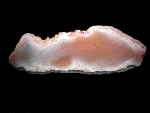
A favourite topic as regards Usan is, of course : "The Blue Hole" Over the years many theories have been proposed as to its location. The hole itself was apparently discovered in the 19th century. Two wealthy collectors allegedly exploited the location : Robert Miln and the celebrated Sir Mattew Forster Heddle, possibly using explosives to do so. The majority of agates from here were a deep grey or cornflower-blue, which you would think suggested the name. Some of the grey or blue stones have a layer of scarlet or orange-red chalcedony at the outermost edge, which is a wonderful contrast. Other colours were similar to stones from other Usan locations, including pinks, whites, yellows, browns and oranges. Stalactitic, as well as tube agates, occurred there also apparently, together with stones that include some proportion of water-level or onyx banding. Usan, in general, is famous for its finely detailed landscape agates, or as they were originally known "Picture Agates" which more suitably fits their appearance as regardless of the appearance of the stones interior it is generally framed with fortification banding, perhaps also with inclusions. This is always suggestive to me of an illustration from a children's book. "The Blue Hole" provided fine examples of such stones. Some say agates from this location ranged up to nodules of 12 centimetres in size and others suggest that agates here may have reached 25 centimetres in diameter.
As regards the specific location of "The Blue Hole" some say that it is no longer accessible, or even lost completely. It has been suggested that it was located within the bounds of a certain field in the general area of Usan House, perhaps existing as a series of trenches or a miniature quarry. Others imagine it was a beach location in the area north of Fishtown of Usan and south of Scurdie Ness, perhaps originally only accessible at low tide and now long since washed away. Some have theorised that it may have been a digging in a nearby railway cutting. The passage of over 100 years would mean that any of these locations might be almost utterly changed from their 19th-century appearances, or could appear just the same, who knows? If somehow, "The Blue Hole" ever becomes accessible again, I will likely be the last to know and in any case, I much prefer beach collecting.
It is in hindsight now, I see that some of the photographed agates, purported as being of the Blue Hole in origin, seem to exhibit what may be water worn skins, indicating they might have been collected either on the seashore, or perhaps in the bed of a nearby stream. Chromatography associated with the influence of seawater and exposure to mineral-rich sands and gravels may also suggest a location at least partially incorporating an area of shoreline or stream-bed. This does not tally with the opinions of most scholars in the field (excepting Peter R. Rogers) who seem certain that agates were quarried from a location in a field in the area of Usan House, or perhaps further north closer to the southernmost extent of the Scurdie Ness location. Agates gathered this way, would generally show distinct, unweathered skins. So it may be that the location of the Blue Hole WAS indeed on the shore, perhaps a digging into the precipitous slopes leading to the shingle, so incorporating weathered material from excavations in the beach cobbles, as well as stones retrieved after blasting away at the bank. At most coastal Angus locations, the material on the beach extends under the encroaching soil inland. Later, of course, supply of the more easily accessible material in the shingle would become exhausted, and further quarrying using explosives would have been the only way to uncover new agates. Perhaps the agate horizon was lost, or worked-out completely, then the area was filled-in for safety reasons, or to stabilise the ground because of nearby buildings.
Presumably the location was sited SOMEWHERE north of Fishtown of Usan, and south of the long shingle coves that may be followed from the lighthouse at Scurdie Ness.
That's my theory anyway.
That being said, I feel I should ask the question, directed at no one in particular : When will someone see fit to publish a book containing as many of the finest examples of agates from the Blue Hole of Usan as possible, along with as much of the local history of the area as can be gathered? Perhaps interviews with some of the local collectors might be included. I presume many of the finest specimens are not on display. The Natural History Museum in Edinburgh no longer has its Blue Hole stones on show, and an appointment must be made in order to see them. Having a handy publication available would rectify this unsatisfactory state of affairs to some extent. I'm surely not alone in having this opinion.












